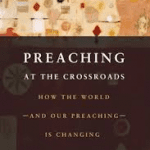It’s the week before Christmas. You haven’t been to church in a year. Maybe in lots of years. Maybe you’ve only ever been to church for weddings and funerals, but this year, something compels you to seek a sacred connection in community. So you scan the newspaper ‘seasonal worship’ ads. You scour the internet. You maybe ask around the neighborhood.
Having found a place that might be the place, you set out on Christmas Eve. Maybe you had to feed, dress and corral a herd of small children into the car. Maybe you’re dragging a spouse or a friend along. Maybe you’re elderly and navigating all this with a walker. Maybe it’s fixin to be some weather out there, but still…you’re going .
You approach the street of the church’s address. You can see the bell tower peeking up above the tree line. You get the corner, ready to turn, and you are greeted by this sight:
Welcome to our church! Outside in the street right now, this is happening. The good news: when it’s done, the road will be wider and come in closer to the church. We’ll be more visible, accessible, and inviting. Bad news: that’s much, much later. Before we get to that, they will have torn up BOTH ends of the road, and you’ll actually have to take a secret passageway shortcut through the neighborhood to get here… and the funnest part is, those detour signs will bring you nowhere near the church! Awesome.
In any season, giant detour signs are a church hospitality nightmare. At Christmas, it is especially unfortunate. I’ve been trying to craft this whole thing into a clever sermon series/marketing angle. “Home by Another Way,” perhaps. Or “Saint Andrew Christian Church: Once You Find Us, You’ll Never Want to Leave.” Yeah, still working out the details on that…
Meanwhile, I’m thinking about the many ways churches put up ‘detour’ signs, limiting access to new people. Often, we don’t even realize we’re doing it. As you ‘prepare the way’ at your place of worship this season, here are some pieces of congregational life to approach with a critical eye:
First points of access: Is the entryway clearly marked for street traffic? Are trees and shrubs trimmed back so that people can easily come and go? Do you have sufficient parking and handicap accessible spots? If events beyond your control—say, a massive road widening project—make your church inordinately hard to find, make sure your website and any publications have CLEAR and VISIBLE driving, parking, and walking instructions for guests. (This is also important if your church is in a downtown area and utilizes various parking structures).
If you anticipate a parking shortage, ask your regulars to arrive early, carpool, take the farthest spots from the door, and/or park on the street (or at a business across the street) and walk a few blocks, weather permitting. And, speaking of weather, have staff or volunteers ready to spring into shoveling and salting action, if needed.
Upon entry: Are buildings and doors clearly marked? Could a young parent wrestling a fussy toddler and a heavy infant seat find their way to the nursery? Is someone on the lookout for that family, ready to show them around and help them feel comfortable leaving their child in the care of a stranger?
Is the narthex/vestibule/lobby, or whatever you call it, free of clutter? Is appropriate church info and literature easy to find, and simple to interpret? Do you have an assertive, yet not uncomfortably so, means of getting follow up contact info? Avoid sensory overload in this area so the important stuff will be hard to miss.
What about entry to the worship space? Greeters are friendly folks. They like to chat—with each other, with people they know, and people they’re just meeting. That’s why they’re greeters! They possess the spiritual gift of chat. However—part of their job, especially on a high traffic day, is to keep that traffic moving, and to gently usher clusters of conversation away from the sanctuary doors (In or out, people, let’s board in a timely fashion so that we can lift off soon!) Remind them of this part of the job, and maybe have extras on hand to help manage overflow areas.
Take a seat. Take A seat, folks. Not an entire row for your family of 12 who will probably be 10 minutes late. Ask your already-members, again, to arrive early, (and all together if they want to sit together). Saved seats are a HUGE detour sign. Also, ask those early-arriving people to scoot in towards the uncomfortable center so that newcomers and late comers don’t have to climb and/or separate from their families.
Also—coats/purses/electronic devices do not need their own chairs. (Ever wish people in airports would remember this?) So, do you have ample (and visible) areas outside of the worship space for folks to hang and stash things?
Speaking of ‘things,’ here’s one of the biggest challenges at our place: our chairs do not have a storage compartment for hymnals and guest registers. So every other chair has a big pile of ‘stuff’ in it. Most folks pick up the pile and move it to the seat next to them. Which means, by the time the sanctuary is half full, there is ‘stuff’ in every empty seat. Can you say “DETOUR?” If I’m a new person, I don’t know what to do with that pile-o-things. In fact, I probably think that someone is saving that seat. (No saving seats!) Once I figure out that I can, in fact, sit there, I still have to move the stuff in order to sit down. Since there’s no compartment in the seat, I spend the service with my hands full of bulletins, inserts, hymnals and whatever else I brought in with me…
I have no solution for this yet, but it is on my list! The takeaway—limit the amount of ‘stuff’ needed to participate in worship; and/or, have an obvious way to stash said stuff when it’s not in use.
Worship space: Is your sanctuary high-ceilinged, high-churchy, full of stained glass and sporting an organ larger than the Sunday school wing? If so, that’s probably meaningful to some. But very intimidating to others. You don’t exactly want to get rid of those 200 year old windows… However, you might think of other ways to put people at ease. A light moment or an invitation to chuckle, near the beginning of the service, sends the message that “we’re all just folks here.” Embrace imperfection. Live in awareness of your church’s shortcomings and liabilities. Humanize the pastor. These are just a few small ways to let some air into the room.
On the other end of the spectrum—maybe your sanctuary is tiny, all your chairs are circled around the communion table, and everybody holds hands and sings kum-ba-ya. This can be an intimidating scenario as well. Try not to smother people. Find ways to create personal space, avoid the word “intimate,” (cause, ew) and maybe reconfigure those chairs on big visitor days.
Language: Ah, Church and words. We have a relationship, and if it were Facebook official, we’d just say “it’s complicated.”
Sometimes, we love big enormous heady words. Let’s call it, church nerd vocabulary. This can be problematic. Not that we should dumb down the message… However, the preacher, the teacher, and the bulletin maker should use sparingly those words that only make sense to the seminarian (or the faithful Sunday School-goer). And if we must plug in terms like didactic, hermeneutical, supersessionism, or anthropomorphism, make sure they are couched in a larger conversation that actually teaches what the word means, and why we should care. (Note: if you’re using more than one of these words in a single service, we’re already asleep).
But then, church nerds also love very short words. Particularly, acronyms. Is your printed material full of initials and abbreviations that make no sense to an outsider? (If you go to a mainline protestant church, I’m 98% sure the answer is yes). So, create a lexicon.
Ok, I could go on…but I’m tired just thinking about all this, and you probably are too. Still, in this season of welcoming the stranger, these little things are every bit as important as the sermon, the anthem, and the decorations we spend so much time and energy preparing. Yes, it is hard work; but the good news is, we are the body of Christ. Together, we have enough hands to do the shaking, enough voices to share the greeting, and more than enough feet to navigate this complicated dance of welcome. And just think of this–this year’s guests are next year’s greeters!
So bring it, Christmas crowd. You might have to sludge through a holy hot mess to get here, but once you find us, we’re not letting you go until you’ve met Jesus in the flesh. When you see him, say hello. Because he’s a stranger too.












